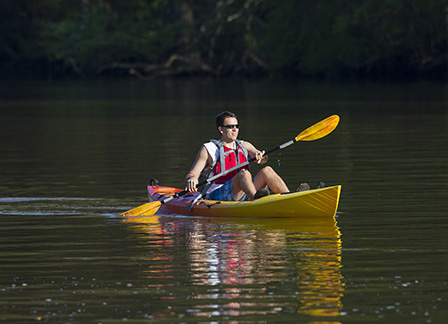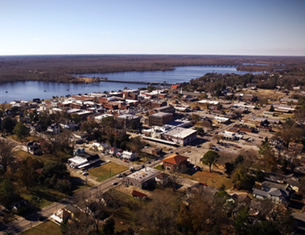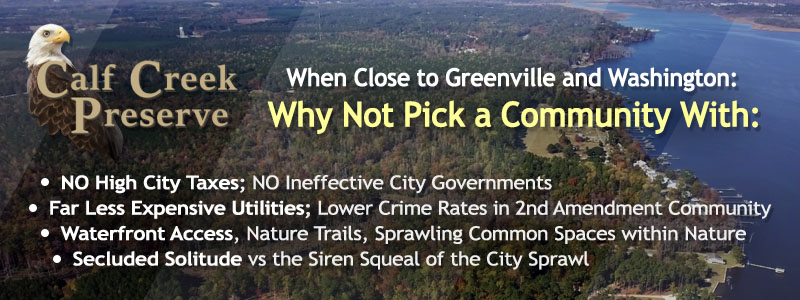The First Amendment Guarantees ALL Freedoms, including a Truthful Press
A Common Thread
Publisher's note: The creator of this article, Crystal Baity, is a author for ECU News Services.
ECU helps Roanoke River towns share, market assets
Windsor Mayor James Hoggard's mom couldn't keep him out of the water when he was a boy. He grew up hunting and fishing on the Roanoke and Cashie rivers in the northeast corner of North Carolina, and still enjoys putting in his boat for some solitude.
"Within two minutes I can be in an area where there are no people," Hoggard said.
 Now Hoggard wants to lure paddlers and fishermen to his piece of heaven, creating a ripple effect in the local economy.
Now Hoggard wants to lure paddlers and fishermen to his piece of heaven, creating a ripple effect in the local economy.
Hoggard and 11 mayors from towns connected by the Roanoke River are collectively marketing their region, spurred by a two-year grant project combining talents from East Carolina University and the Mid-East Resource Conservation and Development Council.
ECU's Dr. Paige Schneider and Mid-East's David Hodges hosted public meetings and focus groups to get input from each of the Roanoke River Mayors Association participating towns - Bear Grass, Halifax, Hamilton, Hassell, Hobgood, Jamesville, Oak City, Plymouth, Scotland Neck, Weldon, Williamston and Windsor.
"This initiative helped these towns tell their story," said Schneider, ECU assistant professor of recreation and leisure studies and affiliate faculty member in the Center for Sustainable Tourism.
"We have rich natural resources and history here in eastern North Carolina," said historian Harry Thompson of Windsor and board member of the Roanoke River Lighthouse & Maritime Museum in Plymouth. "I think that is one of the jewels that we have and that we have to protect because it gives us something that's different from everybody else."
In-depth interviews were recorded with 115 individuals representing stakeholder groups and existing tourism organizations in the 12 towns. Data was collected between August 2010 and December 2012.
Faculty and graduate students in the ECU Department of Recreation and Leisure Studies generated a pilot study to survey business opportunities within the 12 municipalities.
ECU graduate student Brittany Washington, who grew up in Halifax County, said working on the project helped her understand the impact on the community. "The project became personal for me. I saw it with different eyes and saw issues I might not have seen before," Washington said.
Promoting the common good
At first, the towns had to put aside a 'me' mentality and start thinking as 'we.'
"The mayors banded to promote the common good," Hoggard said. "All the mayors get along well. All of us would pitch in to help the other."
The mayors began coordinating and promoting events, meeting bi-monthly, sharing ideas and talking about the challenges - and assets - that they have in common. The river was a common thread along with the history and culture of the region, from cotton and tobacco farming to local foods to Civil War history.
"When I was young, the wetlands and swamps were viewed as wasteland," Hoggard said. "Now they're viewed as an asset. I think people are more cognizant of it now."
The largest town is Williamston, population 5,421, according to the 2012 U.S. Census Bureau. Some of the towns have only a few hundred residents, and working together instead of alone made sense.
"We are trying to bring jobs and money to an area through visitors that might come enjoy what we have with the river that runs through the communities," said Tommy Roberson, mayor of Williamston.
"If you ask anyone in our county to give you a list of assets, they will list the river. We are trying to develop this idea and businesses that will work with that endeavor."
It also benefits the towns individually as other eco-tourism projects have spun off the initial marketing effort. In Bertie County alone, a mill pond is undergoing renovation to help with flood control, a heritage museum has opened in Windsor - population 3,579 - and a small boat launch has been added on the Cashie River with plans for a river paddle and camping trail. Simultaneously Windsor was accepted in the N.C. Small Town Economic Prosperity Program.
 In the past three years, 10 new businesses including campsites, outfitters, guide services, and restaurants have been created in eight of the 12 municipalities.
In the past three years, 10 new businesses including campsites, outfitters, guide services, and restaurants have been created in eight of the 12 municipalities.
"To go to the grocery store and see four or five kayaks on top of cars is exciting, and it's starting to make a difference," said Lucia Peel, who operates a bed and breakfast in Williamston and is chairwoman of the Roanoke River Partners, a non-profit formed in the '90s to highlight the five counties along the river.
A centerpiece of RRP's work has been the development of a system of 15 camping platforms to give paddlers exploring the region a unique place to stay overnight.
Visitors are typically low-impact users of a community's resources.
"These people don't use our jail or go to school," Hoggard said. "The only thing they're going to do is leave some money. And our people can use it. It's improved the quality of life here."
The Roanoke River Mayors Association has joined with RRP to enact the marketing plan for the region.
"The work of this group (RRMA), including ECU as a source for expertise and research support, is incredibly important to the future of eastern North Carolina," said Dr. Deb Jordan, chair of the Department of Recreation and Leisure Studies in the College of Health and Human Performance. "This is really a model for how small communities can come together to make a difference - for themselves, their local communities, the environment, and the future of the entire state."
Partners along the river
The lower Roanoke River basin is the largest intact and least-disturbed bottomland hardwood forest ecosystem remaining in the mid-Atlantic region. It is a haven for more than 200 bird species, plants and animals, flowing past alluvial forests and backswamps toward large floodplains with bald cypress and water tupelo before joining the Albemarle Sound.
 In April, 75 paddlers from Virginia to the Triangle and beyond took to the water at the annual Paddle Days event sponsored by RRP. Almost every parking space was full at the launch at Moratoc Park in Williamston. Such events make a difference in the community, said Wayne Fox, a retired hotel and restaurant manager and one of about 15 volunteers at the paddle.
In April, 75 paddlers from Virginia to the Triangle and beyond took to the water at the annual Paddle Days event sponsored by RRP. Almost every parking space was full at the launch at Moratoc Park in Williamston. Such events make a difference in the community, said Wayne Fox, a retired hotel and restaurant manager and one of about 15 volunteers at the paddle.
"Things like this do so much for a community," said Fox, a former chairman of the Martin County Tourism Development Authority. "If you could get people down here to see what's happening, you could get more people involved. But the big question is how do you get to the people to get them interested?"
The hope is that the RRMA project - combined with each town's own efforts and the complementary work of groups like RRP - will create capacity to make the region a destination.
Goals for the marketing plan include attracting in and out-of-state tour companies to add towns in the Roanoke River Valley region to their itineraries; increasing visits from outside the five-county region; developing regional events; launching a new website; and encouraging new shops, restaurants and bed and breakfasts to open in the region.
 "The local communities benefit from the tourist dollars coming in and the tourists benefit from the encounters with locals," Jordan said. "Travelers to the region come away with an experience - of the local culture, people and environment. It's an incredibly rich opportunity for everyone."
"The local communities benefit from the tourist dollars coming in and the tourists benefit from the encounters with locals," Jordan said. "Travelers to the region come away with an experience - of the local culture, people and environment. It's an incredibly rich opportunity for everyone."
The work's not done
"This 'sense of place' is a common part of their identity," Schneider said. Educating local residents and building awareness for the Roanoke River Valley region's unique culture, history and setting continues. "It's not stagnant; it's organic."
Each of the towns will receive promotional videos and photography that will help market their heritage and share their community stories, Schneider said.
An association website and the use of social media are being discussed. An oral history project expanding on the storytelling that came out of the recorded interviews is a possibility.
Mid-East's executive director David Hodges said ECU was subcontracted to work on the $73,500 N.C. Rural Economic Development Center grant because of the university's tourism expertise and reputation. ECU has been a good partner, and Hodges hopes to work with the university on more projects in the region, he said.
"I think this project will keep building," Hodges said. "There's so much to do."
Go Back
ECU helps Roanoke River towns share, market assets
Windsor Mayor James Hoggard's mom couldn't keep him out of the water when he was a boy. He grew up hunting and fishing on the Roanoke and Cashie rivers in the northeast corner of North Carolina, and still enjoys putting in his boat for some solitude.
"Within two minutes I can be in an area where there are no people," Hoggard said.

ECU's Dr. Paige Schneider, left, has collaborated with town officials like Windsor mayor James Hoggard, right, on the Roanoke River Mayors Association Project.
Hoggard and 11 mayors from towns connected by the Roanoke River are collectively marketing their region, spurred by a two-year grant project combining talents from East Carolina University and the Mid-East Resource Conservation and Development Council.
ECU's Dr. Paige Schneider and Mid-East's David Hodges hosted public meetings and focus groups to get input from each of the Roanoke River Mayors Association participating towns - Bear Grass, Halifax, Hamilton, Hassell, Hobgood, Jamesville, Oak City, Plymouth, Scotland Neck, Weldon, Williamston and Windsor.
"This initiative helped these towns tell their story," said Schneider, ECU assistant professor of recreation and leisure studies and affiliate faculty member in the Center for Sustainable Tourism.
"We have rich natural resources and history here in eastern North Carolina," said historian Harry Thompson of Windsor and board member of the Roanoke River Lighthouse & Maritime Museum in Plymouth. "I think that is one of the jewels that we have and that we have to protect because it gives us something that's different from everybody else."
In-depth interviews were recorded with 115 individuals representing stakeholder groups and existing tourism organizations in the 12 towns. Data was collected between August 2010 and December 2012.
Faculty and graduate students in the ECU Department of Recreation and Leisure Studies generated a pilot study to survey business opportunities within the 12 municipalities.
ECU graduate student Brittany Washington, who grew up in Halifax County, said working on the project helped her understand the impact on the community. "The project became personal for me. I saw it with different eyes and saw issues I might not have seen before," Washington said.
Promoting the common good
At first, the towns had to put aside a 'me' mentality and start thinking as 'we.'
"The mayors banded to promote the common good," Hoggard said. "All the mayors get along well. All of us would pitch in to help the other."
The mayors began coordinating and promoting events, meeting bi-monthly, sharing ideas and talking about the challenges - and assets - that they have in common. The river was a common thread along with the history and culture of the region, from cotton and tobacco farming to local foods to Civil War history.
"When I was young, the wetlands and swamps were viewed as wasteland," Hoggard said. "Now they're viewed as an asset. I think people are more cognizant of it now."
The largest town is Williamston, population 5,421, according to the 2012 U.S. Census Bureau. Some of the towns have only a few hundred residents, and working together instead of alone made sense.
"We are trying to bring jobs and money to an area through visitors that might come enjoy what we have with the river that runs through the communities," said Tommy Roberson, mayor of Williamston.
"If you ask anyone in our county to give you a list of assets, they will list the river. We are trying to develop this idea and businesses that will work with that endeavor."
It also benefits the towns individually as other eco-tourism projects have spun off the initial marketing effort. In Bertie County alone, a mill pond is undergoing renovation to help with flood control, a heritage museum has opened in Windsor - population 3,579 - and a small boat launch has been added on the Cashie River with plans for a river paddle and camping trail. Simultaneously Windsor was accepted in the N.C. Small Town Economic Prosperity Program.

Paddle trips along the Roanoke River are becoming a popular tourist activity.
"To go to the grocery store and see four or five kayaks on top of cars is exciting, and it's starting to make a difference," said Lucia Peel, who operates a bed and breakfast in Williamston and is chairwoman of the Roanoke River Partners, a non-profit formed in the '90s to highlight the five counties along the river.
A centerpiece of RRP's work has been the development of a system of 15 camping platforms to give paddlers exploring the region a unique place to stay overnight.
Visitors are typically low-impact users of a community's resources.
"These people don't use our jail or go to school," Hoggard said. "The only thing they're going to do is leave some money. And our people can use it. It's improved the quality of life here."
The Roanoke River Mayors Association has joined with RRP to enact the marketing plan for the region.
"The work of this group (RRMA), including ECU as a source for expertise and research support, is incredibly important to the future of eastern North Carolina," said Dr. Deb Jordan, chair of the Department of Recreation and Leisure Studies in the College of Health and Human Performance. "This is really a model for how small communities can come together to make a difference - for themselves, their local communities, the environment, and the future of the entire state."
Partners along the river
The lower Roanoke River basin is the largest intact and least-disturbed bottomland hardwood forest ecosystem remaining in the mid-Atlantic region. It is a haven for more than 200 bird species, plants and animals, flowing past alluvial forests and backswamps toward large floodplains with bald cypress and water tupelo before joining the Albemarle Sound.

The town of Windsor, NC constructed the Cashie Wetlands Walkway, pictured above, to help attract eco-tourists to the area.
"Things like this do so much for a community," said Fox, a former chairman of the Martin County Tourism Development Authority. "If you could get people down here to see what's happening, you could get more people involved. But the big question is how do you get to the people to get them interested?"
The hope is that the RRMA project - combined with each town's own efforts and the complementary work of groups like RRP - will create capacity to make the region a destination.
Goals for the marketing plan include attracting in and out-of-state tour companies to add towns in the Roanoke River Valley region to their itineraries; increasing visits from outside the five-county region; developing regional events; launching a new website; and encouraging new shops, restaurants and bed and breakfasts to open in the region.

Recreation and Leisure Studies graduate student Brittany Washington, pictured above, worked with Dr. Paige Schneider on the Roanoke River Mayors Association project.
The work's not done
"This 'sense of place' is a common part of their identity," Schneider said. Educating local residents and building awareness for the Roanoke River Valley region's unique culture, history and setting continues. "It's not stagnant; it's organic."
Each of the towns will receive promotional videos and photography that will help market their heritage and share their community stories, Schneider said.
An association website and the use of social media are being discussed. An oral history project expanding on the storytelling that came out of the recorded interviews is a possibility.
Mid-East's executive director David Hodges said ECU was subcontracted to work on the $73,500 N.C. Rural Economic Development Center grant because of the university's tourism expertise and reputation. ECU has been a good partner, and Hodges hopes to work with the university on more projects in the region, he said.
"I think this project will keep building," Hodges said. "There's so much to do."
| New CLT Airport Authority Lands In Court | East Carolina University, School News, The Region, Neighboring Counties | 'Anything That Bites' |





















